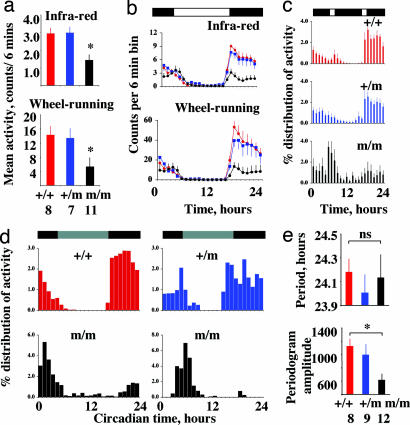Fig. 3.
Temporal redistribution of entrained and circadian behavior in prokr2Brdm1 mutant mice. (a) Mean ± SEM daily levels of total activity monitored by infrared movement detectors and wheel-running. Note significantly reduced levels (P < 0.05) in m/m mice. (b) Temporal distribution of general activity and wheel-running in the final 10 days under LD before transfer to DD. Note attenuation of “dusk” behavior in m/m mice after lights-off but normal “dawn” activity levels around lights-on (mean ± SEM). (c) Temporal distribution of wheel-running under 10 days of skeleton photoperiod (after entrainment to LD) reveals selective loss of activity during early night and relative redistribution of activity to late night in the m/m compared with the +/m and +/+ mice (mean ± SEM). (d) Representative individual activity profiles plotted in circadian time from +/+, +/m, and m/m mice. Data were collected over 10 days starting on the second day of exposure to DD. Note loss of dusk activity at the onset of circadian night in m/m mice but maintenance of activity at the end of circadian night coincident with subjective dawn. (e) Free-running circadian period over the 10 days was not affected by prokr2Brdm1 allele (Upper), but the strength of the rhythm, assessed by the periodogram amplitude, was significantly (P < 0.05) attenuated in m/m mice (mean ± SEM).

